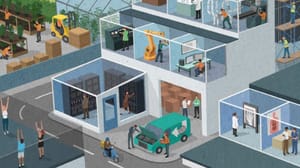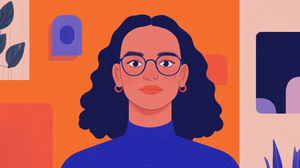Growth begins where comfort ends
Many of us remain tethered to the familiar—clinging to roles, habits, and routines that feel safe but hold us back. For UX product designers, this might mean staying in a comfortable role, defaulting to tried-and-true methods, or avoiding the risk of pursuing leadership opportunities or new challenges.
Stepping into the unknown—whether by seeking a role with greater responsibility, transitioning to a different industry, or advocating for design’s strategic value within your organization—can feel intimidating. However, staying in place has more significant consequences. The longer we delay action, the harder it becomes to create a career that reflects our full potential.
Sometimes, we must embrace the discomfort of uncertainty and use it as a catalyst for transformation. Growth doesn’t require drastic changes; it starts with thoughtful, purposeful actions that move us forward. Whether expanding our skillset, seeking mentorship, or identifying when it’s time to pivot, upgrading our careers starts with the courage to move beyond the familiar.
Read on to find out why focusing on money too early in your career could hold you back, how side projects can enhance your skills and fuel creativity, and why prioritizing learning over immediate rewards sets the stage for long-term success. Discover the steps to break free from the familiar and design a career that aligns with your aspirations.
Building a career with intention
Meaningful careers don’t materialize overnight; they’re shaped by deliberate choices prioritizing growth and learning over short-term rewards. The allure of immediate gains—like a higher salary or a more prestigious title—can sometimes overshadow opportunities to build the skills and experiences that lead to long-term fulfillment.
A career built with intention starts by stepping back, thinking beyond the moment, and focusing on what will contribute to your growth over time.
One of the most common missteps is prioritizing money too early. In the rush to achieve financial stability or external recognition, it’s easy to overlook the value of acquiring knowledge and building versatility. While financial security is important, the skills you develop now unlock future opportunities.
Prioritizing money before growth involves trade-offs that can impact your fulfillment, well-being, and long-term success.
Shifting your focus to learning and aligning your career with your values, interests, and long-term goals can transform your path as a designer.
Burnout and stress
- High-paying jobs often involve high expectations and intense workloads, which can lead to burnout and stress. For designers, this can mean constant pressure to deliver results, leaving little room for creativity, curiosity, or balance.
Losing what matters most
- Focusing too much on money can disconnect you from what truly matters. Overemphasizing financial rewards risks losing the sense of purpose, empathy, and connection that makes design work fulfilling and human.
Investing in long-term growth
- Prioritizing learning and growth over immediate financial rewards often leads to better career opportunities in the long run. Designers who take on challenging roles that offer growth and skill-building set themselves up for greater success and earning potential later.
Short-term vs. long-term happiness
- Chasing money might feel rewarding in the short term, but research shows it doesn’t always lead to lasting happiness. Designers who value growth, meaningful work, and balance tend to find greater satisfaction and well-being over time.
Careers rarely follow a straight line and often involve lateral moves, transitions into new companies or roles, or even temporary steps backward to build the skills and experiences that lead to your goals and long-term growth.
Progress comes from making choices that shape your skills, reflect your aspirations, and distinguish you as a designer.
Sometimes, learning from the right mentor matters more than the job itself. If you can work with someone who embodies the skills, mindset, or career path you want to follow, take it—regardless of the paycheck or job title. Do whatever it takes to learn from them and align yourself with opportunities that help you grow into the designer you aspire to be.
The value lies in creating a career identity that is truly your own.
Continuous learning: the foundation of an intentional career.
Learning makes you more capable and keeps your work exciting and engaging. Whether you master a technical skill, explore a creative passion, or deepen your understanding of a particular domain, each step you take adds to the foundation for opportunities you may not yet see.
Building a career with intention means playing the long game.
It’s about prioritizing meaningful growth, exploring paths that challenge and inspire you, and committing to lifelong learning. By staying focused on growth, you can build a career that’s resilient and deeply aligned with your values and goals as a designer.
Harnessing your passions and focus.
Distractions and curiosity, often dismissed as frivolous, can be powerful guides to untapped potential.
For UX product designers, these moments might manifest as side projects, unexplored ideas, or a lingering interest in something outside your immediate role. Rather than ignoring them, learning to harness these impulses can uncover new passions, spark creativity, and lead to meaningful growth and new opportunities. Taking time to follow your curiosity—even briefly—can open unexpected doors and reveal insights that shape your direction. The challenge is directing your energy toward what truly matters while letting go of what doesn’t.
Purposeful distraction is one way seemingly unrelated tasks or interests can unexpectedly contribute to your growth. You might naturally gravitate toward something more engaging or fulfilling when avoiding one task. Pay attention to where your focus drifts during these moments. What activities or ideas do you naturally turn to when you have free time? These inclinations aren’t random—they often reveal deeper interests or areas of alignment with your authentic self, pointing to where your energy and curiosity naturally flow.
Recognizing and exploring these signals can lead to opportunities that feel both meaningful and fulfilling.
Key benefits of focusing on side projects or purposeful distractions outside of work.
Skill enhancement
- Side projects act as a creative sandbox where you can explore new ideas, tools, techniques, and approaches. They allow you to practice and refine your skills outside work constraints, helping you stay sharp and adaptable in a constantly evolving field.
Improved creativity
- Engaging in side projects or following your curiosity sparks new ideas and perspectives. The freedom to explore personal interests often leads to breakthroughs that can directly or indirectly enhance your design work.
Burnout prevention
- Side projects and hobbies offer a healthy escape from work demands, helping to recharge one’s energy. Taking time for personal interests fosters balance and prevents fatigue from overextending oneself professionally.
Transferable skills development
- Exploring your passions outside of work helps you build valuable skills like time management, problem-solving, and creative thinking. These experiences often translate into your professional life, making you a more well-rounded designer.
Increased job satisfaction and performance
- Pursuing personal interests provides a sense of fulfillment that carries over into your work. Studies show that people who engage in hobbies outside their jobs often report higher job satisfaction and improved performance at work.
Showcasing dedication and creativity
- Your side projects can demonstrate qualities like passion, creativity, and initiative to potential employers or collaborators. They can also showcase a deeper layer of your identity as a designer and set you apart in your field.
Curiosity is another key driver of growth. It often nudges you toward areas where your interests and potential intersect. Exploring a new hobby, digging into a topic that excites you, or pursuing a question you can’t stop thinking about can lead to skills and insights that add depth to your expertise. For designers, this might mean learning about behavioral psychology, diving into data analytics, or experimenting with a creative medium outside your usual scope. No matter how small, these explorations are often more significant than they seem.
Key benefits of following your curiosity.
It makes you a better thinker
- Curiosity encourages questioning existing beliefs and exploring new possibilities. Challenging conventional thinking leads to innovative ideas and fresh perspectives that drive meaningful change.
Predictor of creative performance
- Studies show that curiosity, especially epistemic (the drive to seek new knowledge), strongly predicts creative problem-solving and innovative thinking. This mindset equips you to tackle complex challenges with unique solutions.
Catalyst for breakthroughs
- Curiosity often sparks breakthroughs, as seen in Alexander Fleming’s accidental discovery of penicillin—an observation that led him to investigate further rather than dismiss it. Other innovations, like Post-it Notes, came from open-ended exploration and rethinking ‘failed’ experiments in new ways.
Empirical evidence of impact
- Research confirms that curiosity enhances creative performance by fostering the energy and knowledge needed for original solutions. The process of exploration itself often leads to transformative outcomes.
Fuel for exploration and innovation
- The energy and knowledge gained from curiosity significantly improve the originality and quality of your work. Whether exploring a new design tool or investigating a novel concept, curiosity can lead to unexpected and valuable insights.
When approached with intention, curiosity becomes a compass for growth—guiding you toward breakthroughs that can shape your career and your sense of purpose as a designer.
Your career as a UX designer is more than just the roles you take or the projects you complete—it’s the culmination of choices, risks, and moments of growth that reflect your aspirations and values.
Growth begins at the edge of your comfort zone, intentional decisions shape your path, and curiosity fuels your creativity.
Whether stepping into a leadership role, seeking mentorship, or exploring a passion project, staying aligned with what truly matters to you is key. Embrace the uncertainty of change, invest in your learning, and harness your energy where it has the greatest impact.
The journey may not always be predictable, but it is yours to shape. By stepping beyond the familiar, prioritizing meaningful growth, and following the threads of curiosity, you’re not just building a career but designing a uniquely authentic future.





